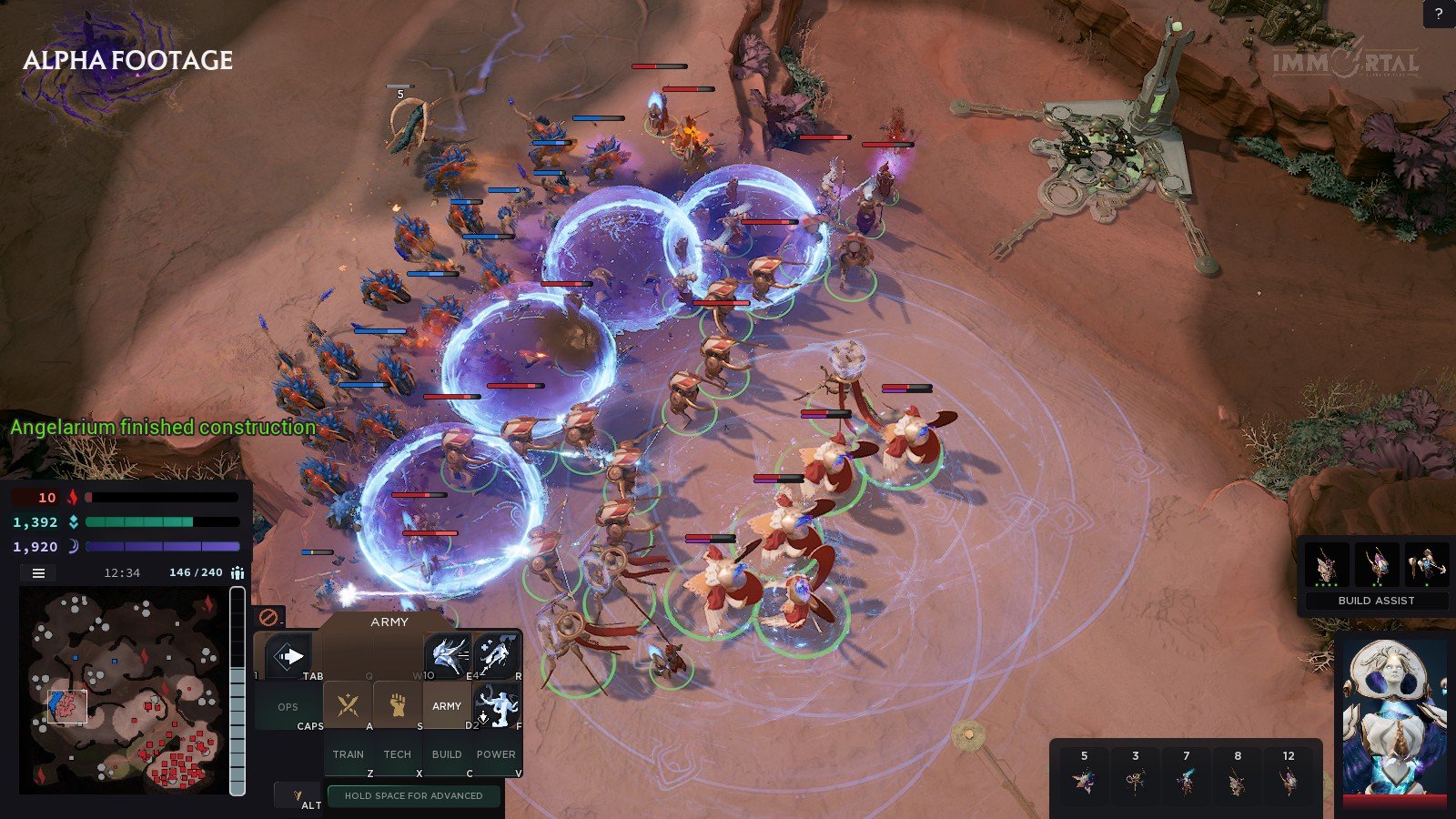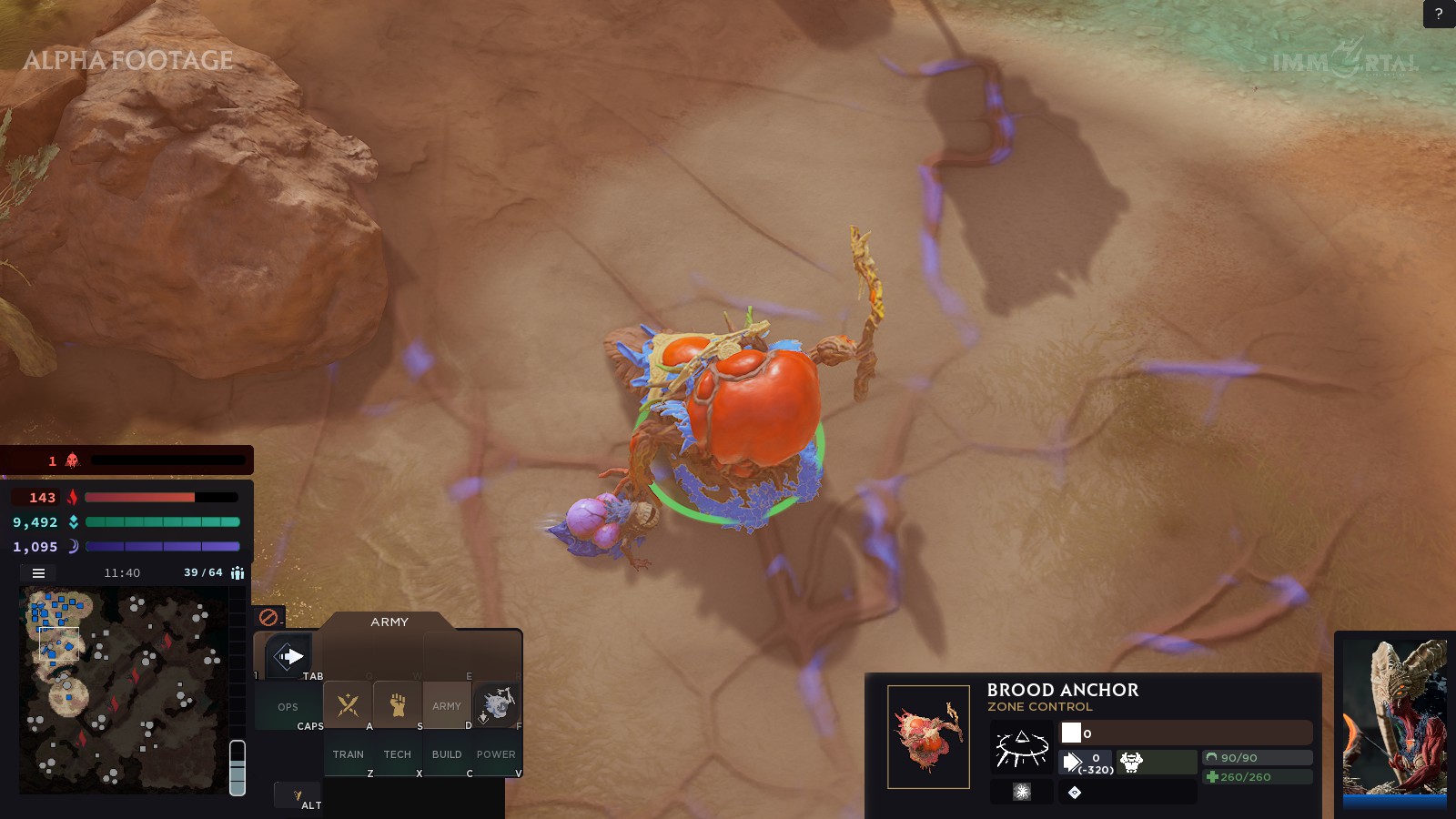
It’s been a busy month for fans of the real time strategy genre. Even as Stormgate ran its early access preview, another crowdfunded StarCraft II inspired RTS, Immortal: Gates of Pyre, offered an open alpha weekend on Steam.
It’s clear IGOP is a long way from finished, but based on what I’ve seen in the alpha, it may be the best opportunity yet to please long-time RTS veterans while also being accessible enough to attract fans who have previously found the genre too overwhelming.
Immortal: Gates of Pyre takes place in a vibrant science fantasy setting of multiple worlds orbiting Pyre, the “god-star.” There are two playable factions available in the alpha, both with spectacular aesthetics
The Q’rathi are glorious angelic beings with a tanky, defensive playstyle, while the Aru are a group of twisted tree-worshiping blood witches. Both do draw some obvious aesthetic and mechanical inspiration from past RTS factions — the Q’rathi have definite Protoss vibes, and the Aru feel like a cross between the Zerg and Warcraft III‘s Night Elves — but there’s more than enough new ideas on display that the factions still feel fresh and original.
According to the game’s Steam page, they’re planning to launch with three factions total (down from the five that were suggested earlier in the game’s development, which is probably a wise concession to realism). The third will be called Jora, the Iron Republic, and based on concept art on the official site, it’s going to be a steampunk faction. I’m hyped.
When playing, you also choose an immortal, with two per faction currently available. These are closest to the major gods of Age of Mythology, with some vibes of StarCraft II co-op commanders as well. Your choice of immortal tweaks your faction by adding two unique units, a passive ability, and several global calldown powers.

Your active immortal powers are fueled by a special resource called pyre. You get a small trickle of pyre at all times, but most of it comes from killing creeps and capturing objectives, which encourages you to stay active on the map and constantly clash with your opponent instead of just turtling.
I fell in love with the Q’rathi from the moment I saw their concept art months ago, and their in-game reality hasn’t disappointed. My preferred immortal is Ajari, Arash of Deliverance, who focuses on healing, shielding, and otherwise keeping your units alive. I’m someone who has always preferred resilience in my RTS factions, so Ajari is my dream come true. So many times I’ve been able to overcome numerically superior forces simply by standing my ground like Leonidas at Thermopylae.
I was disappointed to discover that the IGOP playtest only offers PvP modes. My focus in RTS games (and gaming in general) has always been on story and co-op content. I played 1v1 in StarCraft II for a few months, but I ultimately found it too stressful to stick with. Still, I’ve been excited for IGOP for a while now, so I figured I might as well try one match just to see the game in action.
To my endless shock, I actually had fun. I proceeded to spend an entire afternoon chain-running 1v1 matches, and I enjoyed myself thoroughly the whole time.
I credit this almost entirely to the work developer SunSpear Games has put into accessibility, especially as it pertains to the interface and the economic mechanics.
Everything you need to play IGOP is condensed into a single, simple command card that allows you to quickly toggle between building structures, training units, researching upgrades, commanding your army, and using your immortal powers. When your army is selected, the active abilities of all selected units are available on the command card, without the need for you to tab between unit types or juggle control groups.

SunSpear has also stripped down the number of actions you need to do even the most basic tasks. In a standard RTS, you click or press the hotkey for an ability or an attack move, then click on the map where you want that action to be targeted. In IGOP, these things fire immediately at the cursor’s location without the need for the second click.
These things can take some getting used to for us RTS vets who are accustomed to the old ways, but once I got past the initial learning curve, I found all of these changes made the game feel much smoother to play. This feels like the kind of evolutionary leap the RTS genre needs to become relevant again.
A similar level of innovation is seen in the macro mechanics. Workers are trained and mine resources automatically. As in Stormgate and Godsworn, buildings are placed from the command card, and workers will automatically go to construct them, returning to their original tasks once construction is complete.
Your population cap is increased by building more production structures, so there’s no need for the tedious process of building separate supply buildings, which I have to confess has always been one of my least favourite aspects of the genre.
Similar to Stormgate‘s BuddyBot, an optional automation tool in the from of the build assist feature is available here, though this one is a bit more focused in its purpose. You can set the build assist to automatically train up to three types of units (you choose which three, and you can change your selections at any time mid-match), but it will do so only if you’ve banked over a thousand resources.
When talking about BuddyBot in my Stormgate impressions, I mused that I wasn’t sure how much automation is the right amount for an RTS. Now I know: This is the right amount. It’s always going to be more efficient to stay on top of manually spending your resources, but for us mere mortals who may not be able to keep track of everything when you’re fighting on the field, this makes the game a lot more forgiving. It lowers the skill floor a lot while doing nothing to lower the skill ceiling.

When you add together all these macro and UI improvements, it seems as if Sunspear Games has trimmed away a lot of the fat that makes RTS games so difficult to learn and so stressful to play, without giving up any of the strategic depth that fans love.
I’m still mainly interested in the game for the promised PvE modes that will hopefully arrive in time, as being a hardcore competitive player just isn’t in my nature. But the fact that I had as much fun as I did playing 1v1 shows the devs are doing something right.
And that’s not all of they’ve got right. Aesthetically, the game is already a triumph. The graphics are gorgeous, the art style strikes a perfect balance of stylization and realism, and the sound effects are glorious.
I did notice that none of your units have voice lines currently. I’m not sure if that’s intended or a case of alpha being alpha, but if it is intended, I find I’m surprisingly OK with it. Your immortals have a lot of voice lines while playing, which provides the flavour you’d normally get from unit lines, and voice acting is expensive, so skipping unit voices might be a smart way to save money for a small team like this.
I was continually impressed by how much flavour has been poured into even the most basic elements of the game. Even your structures have incredibly badass names like “Apostle of Binding,” “House of Fading Saints,” and “Murder Hollow.” In any other game, building a new base would be announced with a simple message like “construction started,” but playing as the Q’rathi in IGOP, it’s “By the grace of the throne, a new Acropolis shall rise here!” It’s so extra, and I love it.
The responsiveness you’d want in a competitive RTS is also on point. Unit movement and animations are buttery smooth, and it just feels great to play.

I noticed only a few bits of alpha jank. You can’t leave a custom game lobby, even after the game has concluded; you have to relog to get back to the main menu. Matches also don’t seem to end unless the losing player uses the “gg” surrender button, even if you destroy all their buildings.
While most of the UI and tooltips are very informative, there were a few things that were unclear. Both factions project some kind of aura around their buildings, and I was never sure if those auras do anything outside of the specific interactions some units and abilities have. It also took me a while to figure out how Ajari’s resurrection ultimate works; the tooltip is a bit confusing.
There is a lot to love about this game, but sadly I do have to say that I’m still pretty worried about its future. It was Kickstarted three years ago, and all we have so far is two factions, a single 1v1 map, and a single 2v2 map. There’s no tutorial or even skirmish versus AI. I could never get the 2v2 queue to pop, indicating few testers. There’s almost no hype for the game, and even many RTS fans don’t seem to have heard of it. Its social media accounts have almost no engagement.
I want to be clear I don’t mean this as a criticism, and I’m not trying to hate on SunSpear. Based on what I’ve seen, I have every confidence that the issue is simply a lack of resources, not a lack of talent. What little content we’ve seen has blown me away. But given how long it took to get here and how far there still is to go, I am having a hard time believing that the studio can deliver on its ambitious goals for the game.
The reality is that the recent history of the RTS genre is mostly a graveyard of promising games that failed to gain enough traction to achieve long-term viability, and it’s going to be an even more uphill battle for a team as small as SunSpear Games. Given how much versus AI players have been neglected by other RTS games recently and the inherent expense of developing PvE compared to PvP, I’m also worried the PvE modes may not appear or be underbaked.

But I hope to be proven wrong. Do it, SunSpear; make me look like an idiot. I’d love it.
Whatever the future holds, I can at least say I’ve been impressed with what I’ve seen so far. This is what I’m looking for in a next generation RTS. Aros be praised, our prayers have been answered.
 The world of online gaming is changing. As the gray area between single-player and MMO becomes ever wider, Massively OP’s Tyler Edwards delves into this new and expanding frontier biweekly in Not So Massively, our column on battle royales, OARPGs, looter-shooters, and other multiplayer online titles that aren’t quite MMORPGs.
The world of online gaming is changing. As the gray area between single-player and MMO becomes ever wider, Massively OP’s Tyler Edwards delves into this new and expanding frontier biweekly in Not So Massively, our column on battle royales, OARPGs, looter-shooters, and other multiplayer online titles that aren’t quite MMORPGs.














